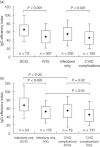Efficiency of immunoglobulin G replacement therapy in common variable immunodeficiency: correlations with clinical phenotype and polymorphism of the neonatal Fc receptor
- PMID: 23286945
- PMCID: PMC3573289
- DOI: 10.1111/cei.12002
Efficiency of immunoglobulin G replacement therapy in common variable immunodeficiency: correlations with clinical phenotype and polymorphism of the neonatal Fc receptor
Abstract
Treatment of common variable immunodeficiency disorders (CVID) is based on replacement therapy using intravenous (i.v.) or subcutaneous (s.c.) immunoglobulin (Ig)G. Interindividual variation of IgG dose is common. A total of 380 CVID patients on stable IgG replacement from two prospective cohorts were analysed. An 'efficiency' index was defined as the ratio of serum IgG trough level minus IgG residual to the average weekly dose of IgG infusion. A reduced efficiency of IgG was associated independently with the i.v. route (P < 0·001) and with the presence of at least one CVID disease-related phenotype (lymphoproliferation, autoimmune cytopenia or enteropathy) (P < 0·001). High IgG efficiency was noted in patients homozygotes for the variable number tandem repeat (VNTR) 3/3 polymorphism of the neonatal Fc receptor gene [IgG Fc fragment receptor transporter alpha chain (FCGRT)] promoter, and this was particularly significant in patients treated with IVIG (P < 0.01). In a multivariate analysis, FCGRT VNTR 3/3 genotype (P = 0·008) and high serum albumin (P < 0·001) were associated independently with increased efficiency of i.v. Ig.
© 2012 British Society for Immunology.
Figures


Similar articles
-
Association of the neonatal Fc receptor promoter variable number of tandem repeat polymorphism with immunoglobulin response in patients with chronic inflammatory demyelinating polyneuropathy.Eur J Neurol. 2024 Apr;31(4):e16205. doi: 10.1111/ene.16205. Epub 2024 Jan 11. Eur J Neurol. 2024. PMID: 38205888 Free PMC article.
-
Association of FcRn expression with lung abnormalities and IVIG catabolism in patients with common variable immunodeficiency.Clin Immunol. 2010 Sep;136(3):419-25. doi: 10.1016/j.clim.2010.05.006. Clin Immunol. 2010. PMID: 20627700
-
Efficiency of immunoglobulin G replacement therapy in common variable immunodeficiency: correlations with clinical phenotype and polymorphism of the neonatal Fc receptor.Clin Exp Immunol. 2014 Dec;178 Suppl 1(Suppl 1):92-3. doi: 10.1111/cei.12525. Clin Exp Immunol. 2014. PMID: 25546776 Free PMC article. No abstract available.
-
Practical aspects of immunoglobulin replacement.Ann Allergy Asthma Immunol. 2017 Oct;119(4):299-303. doi: 10.1016/j.anai.2017.07.020. Ann Allergy Asthma Immunol. 2017. PMID: 28958372 Review. No abstract available.
-
Long-Term Efficacy and Safety of Hizentra® in Patients with Primary Immunodeficiency in Japan, Europe, and the United States: a Review of 7 Phase 3 Trials.J Clin Immunol. 2018 Nov;38(8):864-875. doi: 10.1007/s10875-018-0560-5. Epub 2018 Nov 10. J Clin Immunol. 2018. PMID: 30415311 Free PMC article. Review.
Cited by
-
Cancer Trends in Inborn Errors of Immunity: A Systematic Review and Meta-Analysis.J Clin Immunol. 2024 Oct 28;45(1):34. doi: 10.1007/s10875-024-01810-w. J Clin Immunol. 2024. PMID: 39466473
-
Levels of Natural Antibodies Before and After Immunoglobulin Replacement Treatment Affect the Clinical Phenotype in Common Variable Immunodeficiency.J Clin Immunol. 2024 Sep 21;45(1):13. doi: 10.1007/s10875-024-01805-7. J Clin Immunol. 2024. PMID: 39305354 Free PMC article.
-
Immunological biomarkers associated with survival in a cohort of Argentinian patients with common variable immunodeficiency.J Allergy Clin Immunol Glob. 2024 Jul 23;3(4):100311. doi: 10.1016/j.jacig.2024.100311. eCollection 2024 Nov. J Allergy Clin Immunol Glob. 2024. PMID: 39282620 Free PMC article.
-
Exploiting the neonatal crystallizable fragment receptor to treat kidney disease.Kidney Int. 2024 Jan;105(1):54-64. doi: 10.1016/j.kint.2023.09.024. Epub 2023 Oct 29. Kidney Int. 2024. PMID: 38707675 Review.
-
Association of the neonatal Fc receptor promoter variable number of tandem repeat polymorphism with immunoglobulin response in patients with chronic inflammatory demyelinating polyneuropathy.Eur J Neurol. 2024 Apr;31(4):e16205. doi: 10.1111/ene.16205. Epub 2024 Jan 11. Eur J Neurol. 2024. PMID: 38205888 Free PMC article.
References
-
- Conley ME, Notarangelo LD, Etzioni A. Diagnostic criteria for primary immunodeficiencies. [Representing PAGID (Pan-American Group for Immunodeficiency) and ESID (European Society for Immunodeficiencies)] Clin Immunol. 1999;93:190–197. - PubMed
-
- Busse PJ, Razvi S, Cunningham-Rundles C. Efficacy of intravenous immunoglobulin in the prevention of pneumonia in patients with common variable immunodeficiency. J Allergy Clin Immunol. 2002;109:1001–1004. - PubMed
-
- Favre O, Leimgruber A, Nicole A, Spertini F. Intravenous immunoglobulin replacement prevents severe and lower respiratory tract infections, but not upper respiratory tract and non-respiratory infections in common variable immune deficiency. Allergy. 2005;60:385–390. - PubMed
-
- Quinti I, Soresina A, Guerra A, et al. Effectiveness of immunoglobulin replacement therapy on clinical outcome in patients with primary antibody deficiencies: results from a multicenter prospective cohort study. J Clin Immunol. 2011;31:315–322. - PubMed
-
- Chapel H, Lucas M, Lee M, et al. Common variable immunodeficiency disorders: division into distinct clinical phenotypes. Blood. 2008;112:277–286. - PubMed
MeSH terms
Substances
LinkOut - more resources
Full Text Sources
Other Literature Sources

